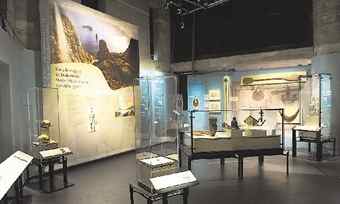Think Easter Island, and one iconic image comes to mind: massive and mysterious stone statues.
 Pointe-a-Calliere, the Montreal Museum of Archaeology and History, presents "Easter Island: An Epic Journey," a collection of 200 artifacts that tell a fascinating tale of island hierarchy, ceremonial rites and unexplained legends of one of the world's most mysterious and faraway places. It is the first major exhibit about Easter Island in Canada and only the second in North America.
Pointe-a-Calliere, the Montreal Museum of Archaeology and History, presents "Easter Island: An Epic Journey," a collection of 200 artifacts that tell a fascinating tale of island hierarchy, ceremonial rites and unexplained legends of one of the world's most mysterious and faraway places. It is the first major exhibit about Easter Island in Canada and only the second in North America.
"Easter Island is the most remote island in the world," said educator and guide Sylvie Pare. "They were totally isolated."
A VERY TINY DOT
Consider that the island's closest South-Pacific-island neighbor is some 1,300 miles away, while the continent of South America, specifically Chile, lies 2,200 miles due east, she said. In addition, to put the island's size into perspective, Easter Island is about one-third the size of the island of Montreal. That's one very tiny dot in that great big ocean blue.
As remote and seemingly inaccessible as the island was, intrepid Polynesian peoples navigated the vast South Pacific waters and reached the shores of Rapa Nui (Easter Island's indigenous name), about the year 1000. They had a rigid social society, said Pare, with a hierarchy that ranked from the top down. A noble class, priests, warriors, experts or the island's master stone sculptors, commoners and serfs were all ruled under one powerful king.
The island's volcanic makeup meant an abundant supply of material for carving. This stone was porous, heavy, but very easy to shape and carve, Pare said.
And carve they did, most notably mysterious monolithic stone figures — or moai — for which the island is most famous. In all, 890 large-size stone sculptures adorn the island. The moai were all made in a central quarry and then transported by manpower along log caravan. The statues were strategically placed around the perimeter of the island.
BIRDMAN WARRIOR
The current government, an autonomous sovereign of Chile, prohibits the removal of any further artifacts from Easter Island. And, of course, the magnificent structures are simply too large to transport, but there are plenty of interesting pieces on display at Pointe-a-Calliere.
Most notable are intricate, very well-preserved foot-tall statues carved from a strong, sturdy South Pacific hardwood. The statues, called, moai kavakava, offer distinguishing features such as prominent eyes, a skinless body and an exposed rib cage. One on display depicts a two-headed version.
Other topics of the exhibit explore the disappearance of many species of trees over the centuries. Yes, climate change and global warming impacted back then as well. El Niño played a big role in particular.
The ritual of the birdman warrior is also explored. The most noble of fighters would swim to an offshore smaller island, braving strong currents a mile away. The prize they sought? The egg of a tern. The one who returned to the main island first was crowned head warrior.
Modern-day explorers who visited over time are also mentioned. British explorer James Cook ventured to Easter Island in 1774, and more recently, Thor Heyerdahl of Norway visited with a group of archaeologists from 1955 to 1956, says the accompanying exhibit timeline. But it was the Dutch explorer Admiral Jakob Roggeveen who is credited with this island's modern day discovery. He arrived on April 5, 1722, an Easter Sunday, giving the island its current name.
Today, some 4,000 people live on Easter Island, about 2,000 of whom claim direct descendancy of the original settlers, Pare said. "Easter Island: An Epic Journey" continues through Nov. 14.
Author: Steve Howell | Source: Press Republican [September 02, 2010]